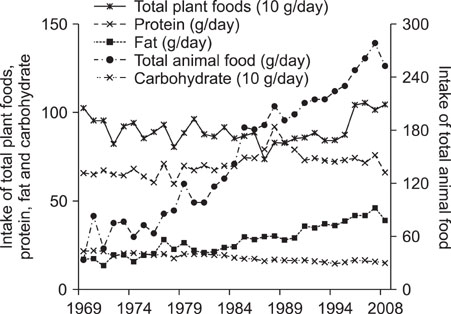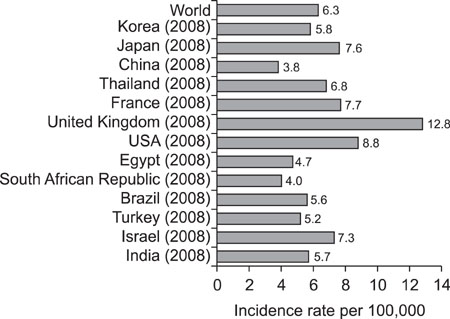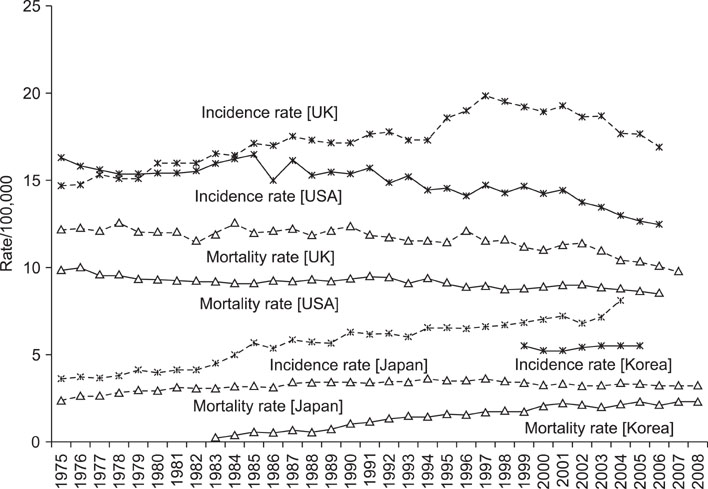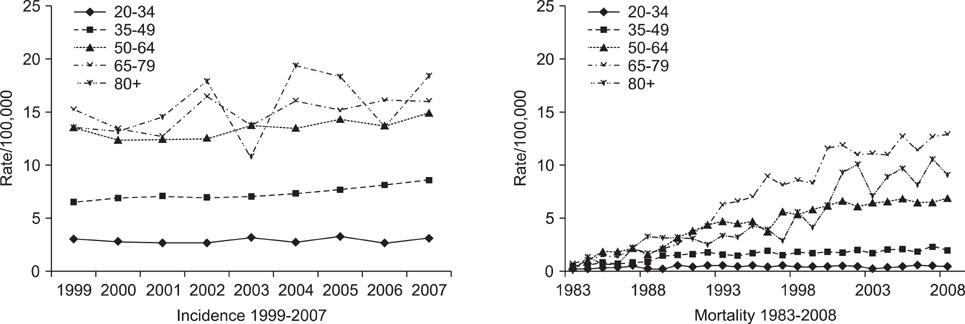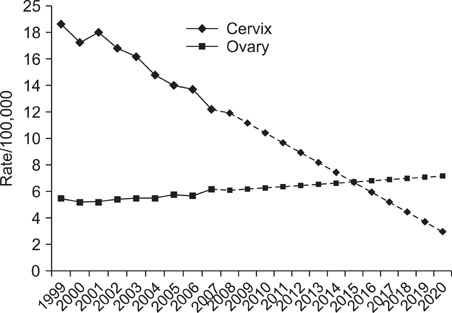J Gynecol Oncol.
2010 Dec;21(4):241-247. 10.3802/jgo.2010.21.4.241.
Epidemiological characteristics of ovarian cancer in Korea
- Affiliations
-
- 1Department of Preventive Medicine, Seoul National University College of Medicine, Seoul, Korea. suepark@snu.ac.kr
- 2Division of Cancer Registration and Surveillance, National Cancer Center, Goyang, Korea.
- 3Department of Obstetrics and Gynecology, Samsung Medical Center, Sungkyunkwan University School of Medicine, Seoul, Korea.
- 4Cancer Research Institute, Seoul National University, Seoul, Korea.
- 5Department of Obstetrics and Gynecology, Asan Medical Center, University of Ulsan College of Medicine, Seoul, Korea.
- 6Department of Obstetrics and Gynecology, Seoul National University Hospital, Seoul National University College of Medicine, Seoul, Korea.
- 7Department of Gynecologic Oncology, National Cancer Center, Goyang, Korea.
- 8Division of Gynecologic Oncology, Department of Obstetrics and Gynecology, Gangnam Severance Hospital, Yonsei University College of Medicine, Seoul, Korea.
- 9Department of Obstetrics and Gynecology, Cheil General Hospital and Women's Healthcare Center, Kwandong University College of Medicine, Seoul, Korea.
- 10Department of Biomedical Science, Seoul National University College of Medicine, Seoul, Korea.
- KMID: 2173548
- DOI: http://doi.org/10.3802/jgo.2010.21.4.241
Abstract
OBJECTIVE
This study was conducted to examine recent trends in ovarian cancer incidence and mortality and secular trends in demographic factors in Korea.
METHODS
With the data from Korea Central Cancer Registry, International Agency for Research on Cancer, Korean Death Registry, and World Health Organization's Statistical Information System, we calculated age-standardized incidence and mortality rates for ovarian cancer. Also we estimated future incidence of ovarian and cervical cancer using linear regression model. To assess the demographic trend, data from national surveys in Korea or results from published papers were searched.
RESULTS
Ovarian cancer incidence rate was similar to that in women worldwide but lower than those in Western countries, and the trend has been increased steadily. Ovarian cancer-related mortality rates have been increasing in Korea, even though those in western and some Asian countries, such as China, have been decreasing. Age-specific incidence rate and mortality rate showed steep increases with advancing age. The incidence rate of ovarian cancer was estimated to surpass that of uterine cervix cancer in 2015. Korea showed rapid changes in nutritional, reproductive, and anthropometric factors.
CONCLUSION
These recent trends in ovarian cancer incidence and mortality may be partly attributed to gradual westernizing of life styles and to changes in socio-demographic behavior factors. In particular, the increasing trend in ovarian cancer mortality in Korea may be attributed to a real rise in mortality as well as, in part, a decline in misclassification bias related to an increase in the proportion of deaths confirmed by physician diagnosis.
Keyword
MeSH Terms
Figure
Cited by 2 articles
-
Is Second Look Laparoscopy for Diagnosing Remaining Ovarian Cancer Appropriate Further Treatment?
Rama Inamdar, Ahyoung Cho, Hae Kyung Yoo, Hye-Sung Moon
Ewha Med J. 2019;42(2):15-19. doi: 10.12771/emj.2019.42.2.15.Cost-effective
BRCA Testing in Advanced Ovarian Cancer
Myungshin Kim
Ann Lab Med. 2023;43(1):3-4. doi: 10.3343/alm.2023.43.1.3.
Reference
-
1. Brewster WR. Temporal trends in ovarian cancer: incidence and mortality across Europe. Nat Clin Pract Oncol. 2005. 2:286–287.2. Olaitan A, Mocroft A, Jacobs I. Patterns in the incidence of age-related ovarian cancer in South East England 1967-1996. BJOG. 2000. 107:1094–1096.3. Globocan 2008 [Internet]. World Health Organization. cited 2010 Jul 15. Lyon: International Agency for Research on Cancer;Available from: http://globocan.iarc.fr/.4. Ministry for Health, Welfare and Family Affairs. Annual report of cancer incidence (2007), cancer prevalence (2007) and survival (1993-2007) in Korea. 2009. Seoul: Ministry for Health, Welfare and Family Affairs.5. Kim K, Zang R, Choi SC, Ryu SY, Kim JW. Current status of gynecological cancer in China. J Gynecol Oncol. 2009. 20:72–76.6. Ahn YO. Cancer registration in Korea: the present and furtherance. J Prev Med Public Health. 2007. 40:265–272.7. Segi M, Kurihara M. Cancer mortality for selected sites in 24 countries. 1966. Sandai: Department of Public Health, Tohoku University of Medicine.8. Parkin DM, Whelan SL, Ferlay J, Teppo L, Thomas DB. Cancer incidence in five continents, Vol. VIII. IARC scientific publication No. 155. 2002. Lyon: International Agency for Research on Cancer.9. Korean Statistical Information System (KOSIS): Annual report on the cause of death statistics. 1983-2005 [Internet]. Korea National Statistical Office. cited 2010 Jul 15. Daejeon: Korea National Statistical Office;Available from: http://www.kosis.kr.10. Altekruse SF, Kosary CL, Krapcho M, Neyman N, Aminou R, Waldron W, et al. SEER cancer statistics review, 1975-2007 [Internet]. 2009. cited 2010 Jul 15. Bethesda: National Cancer Institute;Available from: http://seer.cancer.gov/csr/1975_2007/.11. Mortality and Burden of Diseases Estimates for WHO Member States in 2004, Table 1: Estimated total female deaths, by cause and WHO member state, 2004 [Internet]. World Health Organization, Global Healrh Observatory (GHO). 2009. cited 2010 Jul 15. Geneva: World Health Organization;Available from: http://apps.who.int/ghodata/resources/gbddeathdalycountryestimates_female_2004.xls.12. Korea National Health & Nutrition Examination Survey [Internet]. Ministry of Health & Welfare, Korean Centers for Disease Control and Prevention. cited 2010 Sep 14. Seoul: Ministry of Health and Welfare;Available from: http://knhanes.cdc.go.kr/.13. Cho GJ, Park HT, Shin JH, Hur JY, Kim YT, Kim SH, et al. Age at menarche in a Korean population: secular trends and influencing factors. Eur J Pediatr. 2010. 169:89–94.14. Park MJ, Lee IS, Shin EK, Joung H, Cho SI. The timing of sexual maturation and secular trends of menarchial age in Korean adolescents. Korean J Pediatr. 2006. 49:610–616.15. Park SK, Kang D, Kim Y, Yoo KY. Epidemiologic characteristics of the breast cancer in Korea. J Korean Med Assoc. 2009. 52:937–945.16. National survey data of marriage and fertility transition in 2009 [Internet]. Korea Institute for Health and Social Affairs (KIHASA). 2009. cited 2010 Jul 15. Seoul: Ministry of Health and Welfare;Available from: http://www.mw.go.kr.17. The population statistics [Internet]. Korean Statistical Information Service. cited 2010 Sep 13. Daejeon: Korea National Statistical Office;Available from: http://www.kosis.kr/.18. Population projections for Korea: 2005-2050 [Internet]. Korea National Statistical Office. cited 2010 Jul 15. Daejeon: Korea National Statistical Office;Available from: http://kostat.go.kr.19. Whittemore AS, Harris R, Itnyre J. Characteristics relating to ovarian cancer risk: collaborative analysis of 12 US case-control studies. II. Invasive epithelial ovarian cancers in white women. Collaborative Ovarian Cancer Group. Am J Epidemiol. 1992. 136:1184–1203.20. Kolahdooz F, van der Pols JC, Bain CJ, Marks GC, Hughes MC, Whiteman DC, et al. Meat, fish, and ovarian cancer risk: results from 2 Australian case-control studies, a systematic review, and meta-analysis. Am J Clin Nutr. 2010. 91:1752–1763.21. Ushijima K. Current status of gynecologic cancer in Japan. J Gynecol Oncol. 2009. 20:67–71.22. National Cancer Information Center [Internet]. cited 2010 Jul 15. Goyang: National Cancer Center;Available from: http://www.cancer.go.kr/cms/statics/incidence/index.html#4.23. Kim NI, Lee JH. An analytical review of the methods computing age at first marriage. Korea J Popul Stud. 1995. 18:1–22.24. The pilot result of birth statistics in 2009 [Internet]. Korea National Statistical Office. cited 2010 Jul 15. Daejeon: Korea National Statistical Office;Available from: http://kostat.go.kr/.25. Comparison of estimates according to year [Internet]. Size Korea. cited 2010 Oct 10. Gwacheon: Korea Ministry of Commerce, Industry and Energy;Available from: http://sizekorea.kats.go.kr/.26. Hirabayashi Y, Marugame T. Comparison of time trends in ovary cancer mortality (1990-2006) in the world, from the WHO Mortality Database. Jpn J Clin Oncol. 2009. 39:860–861.27. Nugent D, Salha O, Balen AH, Rutherford AJ. Ovarian neoplasia and subfertility treatments. Br J Obstet Gynaecol. 1998. 105:584–591.28. Brinton LA, Moghissi KS, Scoccia B, Westhoff CL, Lamb EJ. Ovulation induction and cancer risk. Fertil Steril. 2005. 83:261–274.29. Parazzini F, Franceschi S, La Vecchia C, Fasoli M. The epidemiology of ovarian cancer. Gynecol Oncol. 1991. 43:9–23.30. Hwang N. The status of infertility and policy direction in Korea. Health Welf Policy Forum. 2003. 82:88–97.31. Risch HA. Hormonal etiology of epithelial ovarian cancer, with a hypothesis concerning the role of androgens and progesterone. J Natl Cancer Inst. 1998. 90:1774–1786.32. Moorman PG, Schildkraut JM, Calingaert B, Halabi S, Vine MF, Berchuck A. Ovulation and ovarian cancer: a comparison of two methods for calculating lifetime ovulatory cycles (United States). Cancer Causes Control. 2002. 13:807–811.33. Zografos GC, Panou M, Panou N. Common risk factors of breast and ovarian cancer: recent view. Int J Gynecol Cancer. 2004. 14:721–740.34. Kim HR, Hwang NM, Sim JE, Kim EJ. Analysis of the factors related to nutrition and policy issues for healthy future generation [Internet]. 2008. cited 2010 Sep 13. Seoul: Korea Institute for Health and Social Affairs (KIHASA);Available from: http://211.252.146.15/pub/docu/kr/AK/AA/AKAA2008AAQ/AKAA-2008-AAQ.PDF.35. Beral V, Doll R, Hermon C, Peto R, Reeves G. Collaborative Group on Epidemiological Studies of Ovarian Cancer. Ovarian cancer and oral contraceptives: collaborative reanalysis of data from 45 epidemiological studies including 23,257 women with ovarian cancer and 87,303 controls. Lancet. 2008. 371:303–314.36. Jo MW, Khang YH, Yun S, Lee JY, Lee MS, Lee SI. Proportion of death certificates issued by physicians and associated factors in Korea, 1990-2002. J Prev Med Public Health. 2004. 37:345–352.
- Full Text Links
- Actions
-
Cited
- CITED
-
- Close
- Share
- Similar articles
-
- Hereditary Ovarian Cancer: Report of 6 Families
- Clinical Characteristics of Ovarian Metastasis from Colorectal Cancer
- Ovarian metastasis from pulmonary adenocarcinoma
- Associations between metabolic syndrome and gynecologic cancer
- Availability of Transvaginal Color Doppler Sonography to Discriminate Between Benign and, Mlignant Ovarian Tumor According to Tumor Morphology and Blood Flow Characteristics

